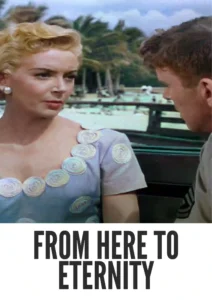Video Sources 0 Views
- Watch trailer
- From Here to Eternity 1953 Colorized


Synopsis
Table of Contents
Toggle
Step back in time to 1941 Hawaii with From Here to Eternity, a powerful romantic war drama from 1953, now stunningly colorized to bring its intense emotions and gripping story to life. This film, directed by Fred Zinnemann, explores themes of love, duty, and betrayal against the backdrop of the looming attack on Pearl Harbor. Perfect for fans of classic Hollywood and those seeking a moving, character-driven story, this HD download offers a fresh perspective on a timeless cinematic masterpiece. Also known as “They Died With Their Boots Clean“.
From Here to Eternity tells the intertwined stories of several soldiers stationed in Hawaii in the months leading up to the attack on Pearl Harbor. Sergeant Milton Warden (Burt Lancaster) begins a passionate and forbidden affair with Karen Holmes (Deborah Kerr), the neglected wife of his commanding officer, Captain Dana Holmes (Philip Ober). Meanwhile, Private Robert E. Lee Prewitt (Montgomery Clift), a talented bugler haunted by a past tragedy, refuses to join the regimental boxing team and faces relentless persecution from his superiors.
As tensions rise both within the army base and on the global stage, the characters grapple with their personal desires, moral obligations, and the looming threat of war. The film culminates in the devastating attack on Pearl Harbor, which forever changes their lives and forces them to confront the true meaning of courage and sacrifice. From Here to Eternity is a poignant and unforgettable drama that explores the complexities of human relationships in the face of extraordinary circumstances.
The film boasts an exceptional cast of actors who deliver unforgettable performances:
-
Burt Lancaster as Sergeant Milton Warden
-
Montgomery Clift as Private Robert E. Lee Prewitt
-
Deborah Kerr as Karen Holmes
-
Donna Reed as Alma “Lorene” Burke
-
Frank Sinatra as Private Angelo Maggio
-
Philip Ober as Captain Dana Holmes
-
Ernest Borgnine as Sergeant “Fatso” Judson
From Here to Eternity is best categorized as a romantic war drama, blending elements of romance, melodrama, and war to create a powerful and emotionally resonant cinematic experience. Its exploration of human relationships and moral dilemmas sets it apart from typical war movies.
Released in 1953, From Here to Eternity reflected the anxieties and uncertainties of post-World War II America. The film’s realistic portrayal of army life and its unflinching exploration of controversial themes challenged the conventions of Hollywood cinema and paved the way for a new era of cinematic realism. The movie was released during the pre-code era. Despite dealing with adultery, prostitution, and military corruption, the film was a box office smash and won eight Academy Awards, cementing its place as a landmark in film history.
This colorized version of From Here to Eternity has been carefully processed using state-of-the-art digital technology, enhancing the visual impact of the film while preserving its original emotional depth and dramatic intensity. The colorization process involved meticulous attention to detail, ensuring that the colors accurately reflect the historical context and enhance the storytelling. The exact software remains confidential, the techniques used incorporate advanced algorithms to enhance and select the color palette and imagery. This painstaking process gives new life to the characters and settings, making the story even more relatable for modern audiences. Although some viewers may prefer the original black and white version, colorization can introduce classic films to new viewers, ensuring their place in film history for years to come.
-
: Fred Zinnemann
-
: Daniel Taradash
-
: the novel by James Jones
-
: Burnett Guffey
-
: William Lyon
-
: Columbia Pictures Corporation
-
: Columbia Pictures
-
: 118 minutes
-
: MP4
-
: HD (1080p)
-
: Compatible with various devices such as computers, smart TVs, tablets and smartphones.
From Here to Eternity (1953) is widely regarded as one of the greatest films ever made, earning critical acclaim for its powerful performances, compelling storyline, and insightful exploration of human nature. The film won eight Academy Awards, including Best Picture, Best Director, and Best Supporting Actress for Donna Reed. It remains a timeless classic that continues to resonate with audiences around the world. As a film, From Here to Eternity gives a unique look into the lives of soldiers before the attack on Pearl Harbor.
-
: What is From Here to Eternity about?
-
A: From Here to Eternity explores the lives and loves of a group of soldiers stationed in Hawaii in the months leading up to the attack on Pearl Harbor.
-
-
: Is From Here to Eternity (1953) a well-known film?
-
A: Yes, From Here to Eternity is a highly acclaimed and widely recognized classic of American cinema.
-
-
: Is this version of From Here to Eternity colorized?
-
A: Yes, this version has been professionally colorized to enhance the viewing experience.
-
-
: What makes From Here to Eternity so special?
-
A: From Here to Eternity is celebrated for its powerful performances, compelling storyline, and its exploration of universal themes such as love, duty, and sacrifice.
-
-
: What is the download format?
-
A: The download format is MP4, which is compatible with most devices.
-
-
: What resolution is the download?
-
A: The resolution is HD (1080p), providing a high-quality viewing experience.
-
Watch From Here to Eternity Today!














